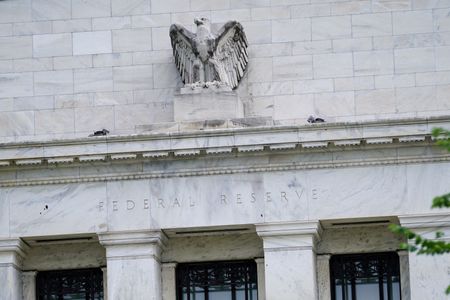By Indradip Ghosh
BENGALURU (Reuters) -The U.S. Federal Reserve will wait until September to cut its key interest rate, according to a majority of 100 economists polled by Reuters, with half saying there will be only two cuts this year and only about a third forecasting more.
That change in the outlook – from a June start and two or more additional cuts in a poll published a month ago – follows evidence of persistent strength in the U.S. labor market and a series of stronger-than-expected inflation data.
Fed Chair Jerome Powell also said on Tuesday “the recent data … indicate that it’s likely to take longer than expected to achieve that confidence” that inflation is falling back to the U.S. central bank’s 2% target, remarks that dimmed hopes for rate cuts anytime soon.
Financial markets, which earlier this year were pricing six Fed rate cuts starting in March, are also expecting the first reduction in September and one more in either November or December.
While Reuters polls have consistently forecast fewer Fed rate cuts than markets, both have now come into line in the latest survey following last week’s inflation report, blowout retail sales data and more hawkish remarks from Powell.
Just over half of economists surveyed, 54 of 100, predicted the first decrease in the federal funds rate to happen in September, pushing that rate to the 5.00%-5.25% range. Twenty-six forecast a July cut and only four said it would happen in June.
Last month a two-thirds majority, 72 of 108, expected the first rate cut in June.
“This is an economy that surprises us again and again by just how resilient it is. We are having very strong growth and it doesn’t seem like the Fed’s policy has made that much of a difference,” said Jonathan Millar, senior U.S. economist at Barclays.
Millar now expects the Fed to cut only once this year, in September, a change from his previous prediction of 75 basis points of rate cuts starting in June.
The personal consumption expenditures (PCE) price index, which the Fed uses to gauge progress toward its 2% inflation target, rose to an annual rate of 2.7% in March, faster than the 2.5% reported for February, according to estimates presented by Fed Vice Chair Philip Jefferson this week.
The outlook for the various inflation measures – the consumer price index (CPI), CPI excluding food and energy, or core CPI, PCE and core PCE – were broadly upgraded from last month in the latest Reuters survey. None of these measures of inflation were expected to reach 2% until at least 2026.
“They say again and again policy is restrictive, but there’s a lot of metrics that may suggest they’re not nearly as restrictive as they think … the neutral policy rate in nominal terms is maybe 4.5% to 5.0%. That suggests they’re not overly restrictive,” Barclays’ Millar added.
Although there was no majority on how many rate cuts would be delivered this year, half of the participants, 50 of 100, saw two quarter-percentage-point cuts, 34 said more than two, 12 saw only one reduction and four said none.
A 60% majority of economists who replied to an additional question, 36 of 60, said the chances were high or very high the Fed would hold rates steady for the remainder of this year. The rest said the probability was low or very low.
A few economists now expect the federal funds rate at the end of 2025 to be at least 100 basis points higher than they were expecting just recently, underscoring how quickly the outlook has changed.
Steve Englander, head of North America macro strategy at Standard Chartered, said the March CPI data “raise the possibility inflation is proving harder to stamp out than the Fed had thought.”
“We have delayed our first cut, but also see a rising probability stubborn inflation will shift the question from ‘when’ to ‘whether’,” he said.
The U.S. economy was forecast to expand at an average 2.3% this year, up from the 2.1% forecast last month.
(For other stories from the Reuters global economic poll, click here.)
(Reporting by Indradip Ghosh; Polling and analysis by Sarupya Ganguly and Rahul Trivedi; Editing by Ross Finley and Paul Simao)

